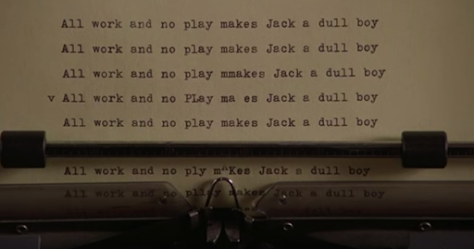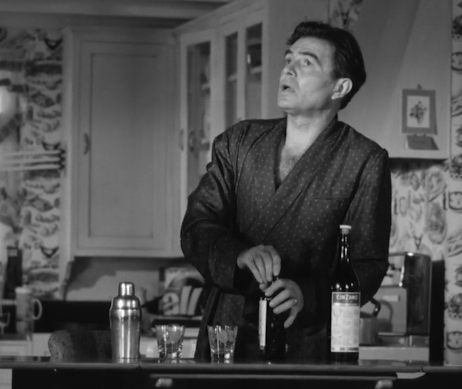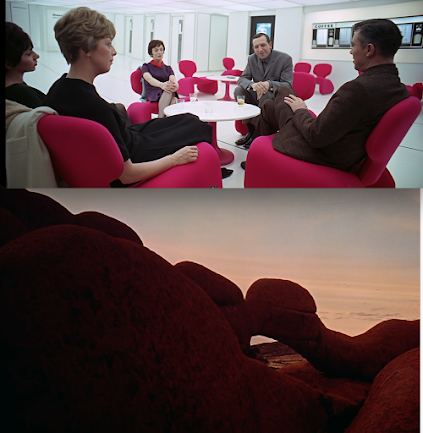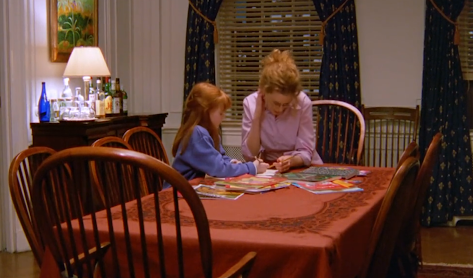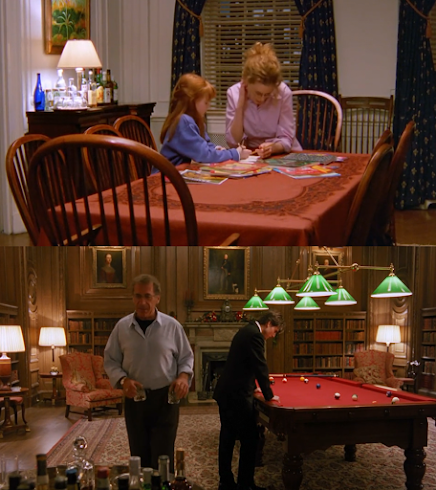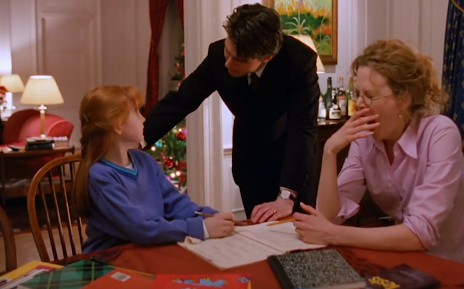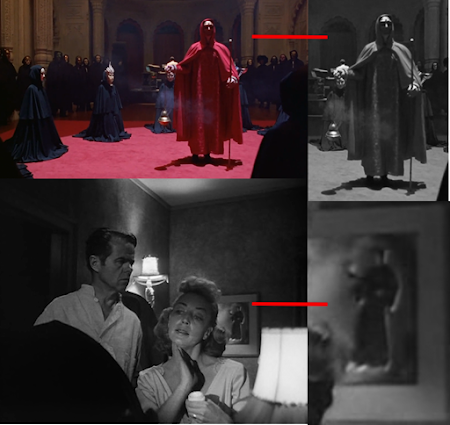2. The connection we could make is that Bill wants to dial back the Enlightenment 50 years. 1789 - 50 = 1739. This is fine: 1739 or, 1740 places us in the territory where the Plantation Act is imminent. In Stanley Kubrick: New York Jewish Intellectual, film scholar Nathan Abrams considers Bill Harford's urban residence, medical profession, and general unmanliness as indicators of Bill's Jewish identity. These details not so surprisingly parallel those provided in Schnitzler's novella, in which the doctor, Fridolin, who lives in decadent Vienna, is virtually cuckolded by his blond wife. The point is that as an outsider, Bill wants to be included; this is at least a part of what makes Somerton the critical center-point of the film. Bill will be humiliated and singled out. His initiation is illegitimate and he is cast out once again.
Also of some interest here is that the American Revolution (1776-1783; spanning 7 years) came just 6 years before the French Revolution. The 13 Colonies became sovereign and independent by 1783 via the Treaty of Paris. The American Revolution sparked revolutions across the world, especially in France. The main difference, however, is that the American Revolution was fought to uphold a new government, whereas the French Revolution was fought to destroy the existing one.
3. This one is fairly obvious. The French Revolution would result in income inequality, death, and destruction, and a coup-d'etat by Napoleon. But it would allow free markets, popular sovereignty, significant reduction of power held by Church and State, and greater liberties. Failure and success are rife in the history of this Revolution. The Marxist-Classic reading regrettably celebrates the idea that the working class wanted to overthrow the elite. In fact, anarchists used violence, destruction, and terror to gain power. Rather than draw meaningful distinctions between powers (I.e., Church and State), the anarchist, proto-Socialist revolt proved little more than a decentralized upheaval. The Monarchy became the bogeyman responsible for all ills of French life. Yet, capitalism grew after the revolution. No Revolutionary leader assumed power or authority in a post-Revolution France. And the revolutionaries were against private wealth, no? Pierre-Joseph Proudhon, the anarchist born ten years before Marx, likely supplied the latter with influential ideas - the absurdity of property, economic reform, collective ownership, and demilitarization.
Bill tearing a bill in half may be an oblique reference to an ouroboros, itself a reference to infinity, wholeness, and destruction. Additionally, defacement of currency is illegal in the United States. So, Bill, whose name obviously mirrors "bill" used to denote paper currency, is paradoxically created in order to be destroyed or denigrated. The snake of the ouroboros eats its own tail: the snake must decrease in size as it eats itself to death. Money, too, is reduced when it is divided. Bill bargains for more with less. He wants more than he can afford. Leave the accusations to Victor who tells Bill, "You've been way out of your depth for the last twenty-four hours." The funny thing too being that many of the things money can buy, or actuate, are infinitely worse than the defacement or denigration of money itself. Of course, Bill's disregard for this secular, Nationalistic/Bureaucratic sin may just be an indication of Bill's inherent corruption and vice. It isn't what "should be," but what "is."
And now to a series of darker connections.
From the $100 bill we arrive at the Franklin Scandal (1988-1991) - again, the keyword is "Franklin." These stories would have been calming down (or heating up?) by the late nineties, when Eyes Wide Shut was being filmed. Lawrence E. King Jr., manager of Franklin Community Federal Credit Union in Omaha and Republican Party donor, had defrauded the bank of $40 million, creating for himself a lavish lifestyle replete with multiple homes and wild parties. White collar crimes aside, male and female sexual abuse victims named King among other elite abusers. Through force and intimidation, the Douglas County court safely dropped charges, concluding that such allegations were a hoax. King would spend ten years in jail, but the prostitution leads would be forbidden. Gary Caradori, the Senate-appointed investigator into the Omaha, Nebraska prostitution and child abuse case, was mysteriously killed in a plane crash along with his young son days after solidifying seemingly damning evidence which could have changed things entirely. The 1994 documentary Conspiracy of Silence which, though set to air, never made it to television, covers the story in shocking detail. For example, the witnesses, such as Paul Bonacci, Alisha Owen, and others were threatened with perjury charges if they continued with their case. Owen spent over four years in jail. Others, including victims' family members, were mysteriously disappeared and killed. King would relocate to the Swamp, aka, Washington D.C. upon his release and subsequent domestic exile.
Around the same time, Craig Spence was being investigated for credit card fraud linking him to a homosexual escort service. As The Washington Times reported in 1989, Spence had obtained keys to the White House in order to give secret late-night tours of the building to male prostitutes. Spence, who worked for the State Department and lobbied for Japanese and American business relations, later committed suicide in a D.C. hotel room. Also in the mid-80s, former House of Representatives member, Barney Frank, was involved in a scandal that brought to light his relationship with a male prostitute who conducted escort services out of Frank's D.C. townhome. Apparently, this did little to hinder his nascent political career.
I guess the logical thing to do here is mention that 1,200 human bones from 15 bodies have been discovered in Ben Franklin's old townhome in London, on 36 Craven Street ("Craven" being a coincidental echo of Wes Craven, pioneer of American horror film). The main excuse is that anatomy was a new science and experiments with human bodies were necessary. Likely, the bodies were already deceased, retrieved from graves to be studied.
The mystery persists: Freemasonry, money, the dual-symbology of the Enlightenment and subsequent "decline" into the Industrial Age (commodification, capitalism, Lassiez-Faire economics, etc). Notably, Franklin signed the Declaration of Independence, the Treaty of Paris, and the Constitution. Franklin's 13 virtues had some influence upon the newly founded Hasidic Jewish community in mid 18th-century England in what is known as the Musar movement. Franklin, as we are taught in America, would document performed virtues on a calendar, like a moral equivalent of present-day calorie-tracking apps. His self-improvement agenda arguably rivals Strauss-Howe thinking on cycles and generations.
The Musar movement, concerned with Jewish ethics, adopted a similar methodology. The research on Ben Franklin presented in the video by Dr. Michael Shire is revealing and somewhat fascinating. The irony is that the "Franklin Prophecy," printed in 1934 by pro-Nazi American William Dudley Pelley, and supposedly transcribed from Franklin's notes by Charles Cotesworth Pickney, the Minister to France and southern Federalist statesman in the early 1800s, suggests the opposite: namely, that Franklin hated Jews, thought they were vampires, that they preyed on the blood of Christians, and were a degenerate "Asiatic" race. Clearly, Franklin was a rationalist, a free-thinking person of privilege. There's no good evidence that Franklin was an anti-Semite. As the Franklin Scandal shows, evil is perpetrated by all people - a fact which is as damning as it is hopeful - Lawrence King Jr., aka, "Larry King" was black, Midwestern, and Republican.
But, back to the table:
Scotch is a possible nod to the Scottish Rite (Freemasonry) which, though its origins date to 17th century England, were promulgated by the well-to-do in Colonial North America in places like Pennsylvania, South Carolina, and Jamaica. The Scottish Rite was formally created in Charleston, SC, in 1801 by eleven members, at least six of whom were Sephardi Jews, the others being French, Scots-Irish, and English. We just finished establishing the connection between Franklin and the Enlightenment origins of Hasidism - the theme of Jews and Freemasons simply won't abate.
The presence of Helena working on her math problem involving money (coded as class and power) could be banal, or, tragic. Again, the $100 bill. Banal, because these elementary math problems are very common. Banal, because Alice is helping. Tragic, because money can be substituted as a type of moral virtue or value and taught to children at a young age. Tragic, less obviously, in that Helena is symbolically present at Ziegler's billiards table. Bill deceives Alice - or does he? And similarly, Bill deceives Helena - or does he? There could be implied a particularly dark reading of Helena as a cynical, privileged only-child. The stereotype of the only-child as narcissistic, spoiled, and controlling, may be a warning. Note the resemblance to Alice Helena has: reddish blonde hair, pale skin, etc. Helena's age is given as seven years old. Mandy is dead by thirty, and Bill wants some explanations during his talk with Victor.
We may describe a coworker in terms of what they "bring to the table," i.e., their talents, skills, etc. Enough evidence paints Victor as a skilled liar and deceiver. He brings magical deception to the billiards table where he attempts to play Bill (note "Bill" and billiards - Bill is an inanimate object meant to be "knocked around"). The tragic irony of having a truthful, serious discussion in a game room is proof enough of Victor's craftiness - hence the name "Victor:" history is written by the victors. The girl is "history" and Victor gets to "write" her story. The tabloid's story is little more than some details surrounding an unknowable mystery. Victor insists that Bill is "playing" when in fact Bill is pursuing truth, while Victor's supposedly true story is a poorly-crafted lie. But the expression has some literal meaning when it comes to the symbolic presence of Helena at the other red table. Bill brings his family to Ziegler's billiards table, because he fears for their safety and well-being. The comedy or tragedy of Eyes Wide Shut is that the most significant part of the story takes place after the film ends. It offers no resolve, and therefore seems designed to say hope is necessary, while also criticizing the often misguided forms of hope that plague the blind, materialistic Harford's.
This would be a thesis on Eyes Wide Shut read through the lens of Aquinas's morality ...which I don't really have time for. Though I would point out that Aquinas documented seven vices and seven virtues. And I would also point out that the number "7" figures considerably into Eyes Wide Shut and other Kubrick movies, and that, though the mystical significance of "7" is nothing new, it should not be ruled out when considering Kubrick's many masterpieces.
Also:
An uncanny connection between The Killing and Eyes Wide Shut potentially exists in a framed picture in George and Sherry's bedroom and the actual figure of "Red Cloak" in the latter film. The figure in the picture appears to be cloaked, either seated or floating, near a cloud of smoke. Red Cloak wears a hooded cloak and swings a censer of burning incense which clouds the hall at Somerton. Also, as others (KDK12) have noted in The Shining, there is a subtle detail which crystallizes the notion of evil and sin: Red Cloak swings the censer in counter-clockwise circles, while himself walking a counter-clockwise circle with the eleven figures around him. Like Ziegler's billiards balls he's just "knocking around," Red Cloak bears an uncanny resemblance to the notion of a careless, destructive tyrant. Or, to the contrary, as we know Victor is a deceptive liar, a careful, meticulous tyrant. A tyrant like this is tied to Lucifer. The difference, though, is that these men were never angels.
The eleven slaves/victims are like planets which revolve around a central mover. Sherry, as a sex symbol, would be the unmoved mover in The Killing, as she simply sits back and watches death and destruction ensue.
I'm closer to accepting a hypothetical gambit that all of Kubrick's thirteen (13) feature films are meant to be viewed and analyzed in relation to each other, like chapters in a single novel. Borges used a myriad of voices to write stories which frequently and intentionally explore interrelated themes, time periods, and symbols. In Kafka, too, single chapters could comprise entire novels: characters, setting, mood and atmosphere conspire to create interminable complexity and drama.
Even the "01 and 10" theory about Radiohead's 3rd album, OK Computer, and 7th album, In Rainbows, fares pretty well for music fans. 3 and 7 added equals 10. For one, both album titles are spelled with 10 letters (two-lettered word followed by an eight letter word, and one space), OK Computer was originally conceived as "Ones and Zeroes," and the transitions starting with the end of the first track of OK Computer and the beginning of the first track of In Rainbows are somewhat uncanny when using a 10-second crossfade. Each track's lyrics are said to correspond to the same numbered track of the other. And, though OK Computer has 12 tracks (making 22 total), 22 is echoed again because there are 11 characters in each album title when the single space is counted (two OK Computer tracks play back-to-back at the center).
One could simply join the two album titles to get a statement "OK Computer In Rainbows," which might suggest striping or splicing the albums, which is exactly what 01 10 is about. Also, computers, like Compact Discs, use binary (codes containing only variations of 0s and 1s) for data storage. Plenty have dismissed the fan theory as nonsense. I don't really care whether its valid or not, because there's enough evidence and coincidence to make it interesting, which is what matters when its music, art, or film that we're talking about. We don't know what it means, but we know that it means, and that is something.
